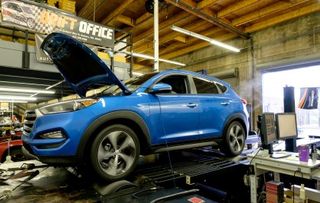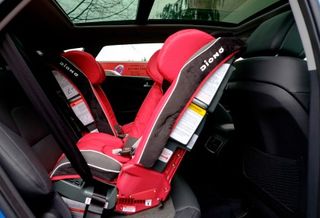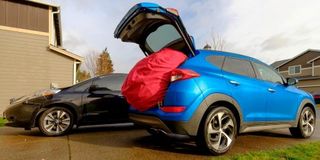Why you can trust TechRadar
Hyundai equips the Tucson Eco, Sport and Limited with a 1.6-liter turbocharged four-cylinder motor matched to a 7-speed dual-clutch transmission (DCT), with your choice of front or all-wheel drive (AWD). The model I drove has AWD. The turbocharged powertrain and DCT is rated for 175 horsepower (hp) with 195 pound-per-foot (lb-ft) of torque.

To verify the rated power numbers, I took the car down to Drift-Office, a local tuning shop owned by a good friend of mine in Auburn, Wash., to put it on a vehicle dynamometer (dyno) and measure how much horsepower the car generates. It was a chilly and wet Washington day, with an average temperature 55 degrees Fahrenheit and an average humidity of 92% at 69 feet above sea level on the day of my visit. The car was strapped down and ran four times.

The numbers the Tucson puts down at the wheels is truly impressive, with 172 hp and 196 lb-ft. There's virtually no power loss through the drivetrain, so either Hyundai's DCT is very efficient or the engine is highly underrated. To put things into perspective, typical AWD cars lose 25% to 30% of its engine power through the transmission. I was expecting the Tucson to make around 130hp at the wheels, but it surpassed my expectations.
You might be curious about the run with a max power of 156 hp depicted above, which did happen. However, it was the third run where the car suffered some heat soak from being stressed with nothing but a giant blower fan as its source of cool air. This is not something you typically experience on the road.
Driving the Tucson around town reveals that the car is quite refined, with smooth power delivery and quick shifts from the DCT. The car never feels starved for power and performs well getting up to highway merging speeds.

Due to the design of DCTs, which more closely resembles a manual than a traditional automatic transmission, early units would shudder at low speeds where you're inching forward in-traffic, like a manual transmission. Fortunately, the DCT in the Tucson doesn't exhibit this behavior very often, and the typical driver won't notice it.
Since the Tucson isn't a high-performance vehicle of any sort, steering wheel-mounted paddle shifters are absent. Hyundai provides a manual mode that lets you select the gear, but the selections are more of a suggestion than anything. If you reach the engine redline or drop below a certain amount of revolutions per minute, or rpm, the transmission will automatically upshift or downshift for you, so you don't have full control over the transmission gearing. I find this annoying but it's not something I'll mark the car down for, since it's not a performance vehicle.
Hyundai did a remarkable job on the suspension tuning. The car handles twisty roads well, with minimal body roll while the struts smoothly absorb bumps in the road, resulting in a smooth and comfortable ride. Steering, on the other hand, could be better. Hyundai employs its drive select mode, which lets you choose between Normal, Eco and Sport driving modes. Your selection alters the throttle response, transmission shift points and steering feel.
Since the Tucson features an electric-power steering motor mounted on the steering column, it suffers the same fate as other systems. There's very little road feel, and it doesn't have a "just right" drive mode (i.e. one that feels natural), unlike the larger Sonata 2.0t Sport and Kia Optima SX, which have the power steering motors mounted on the steering rack.
The normal drive mode has the right amount of precision but feels too light, while the sport mode doesn't feel as precise: it applies too much force and feels artificial, but has the right amount of weight that I like for steering. Ultimately, I left the car in normal most of the time and got used to the lighter feel of this mode. Steering feel might not be something that you're shopping for, but if it doesn't bug you, the Tucson is a fine car to drive.
The US Environmental Protection Agency rates the Tucson with the 1.6-liter turbo motor at 24 miles per gallon (mpg) in the city, 28 on the highway and 26 combined mpg, which is comparable to gasoline competitors. It falls short on the highway fuel economy when compared to the Honda CR-V and Mazda CX-5, but the torquey turbo motor is worth the lower fuel economy for me.
During my time with the Hyundai Tucson, my fuel economy hovered around 22 to 23 mpg, according to the vehicle's trip computer. Drivers that are much easier on the gas pedal than me – I have a lead foot – should experience slightly better fuel economy.
Living with the car
Crossovers are the default car most families look at when kids get introduced into the mix. We partnered up with Diono, a car seat manufacturer, to test-fit three car seats in the back of the Tucson. Diono's USA headquarters is in Puyallup, Wash., where I conduct vehicle testing and a convenient place to stop by and test-fit car seats. With the help of Diono, we attempted to install three Radian RXT convertible car seats in the back of the Tucson.
The Tucson has two pairs of lower LATCH anchors for the outboard seats while the middle seat requires the use of the three-point seat belt. All three seats have top LATCH anchors available. The car seats were installed using the vehicle seat belts and not LATCH anchors.

Unfortunately, the Tucson failed this test. Three car seats could not be installed safely in the back, regardless of whether they were front or rear-facing. The placement of the belt buckles makes it impossible to do so in the middle and driver side rear-seat. It's a shame, because there appears to be enough physical space to fit three car seats. If Hyundai updates the buckle design, I'll gladly revisit this and update the review accordingly.
Junk in the trunk
Hyundai employs the same hands-free smart trunk feature as the Kia Optima in the Tucson. It works the same way: walk up to the locked car with the key fob in your pocket and it automatically opens for you. The Tucson implementation works a lot better, with the inclusion of a powered trunk that opens without your intervention.
So, in the ideal scenario, you walk up to the Tucson with your hands full of Star Wars toys, wait a few seconds and the trunk opens for you. You load up all the toys, press a button to close the trunk and hop in the car and drive off. I did not experience this ideal scenario exactly, but the hands-free smart trunk worked every time.
The Tucson has a cargo area of 31 cubic feet, which is plenty of space to accommodate luggage for a family road trip. I keep a Sumo Gigantor and Omni from Sumo Lounge around for trunk space testing. The Gigantor is a little too big to carry in and out of my house, so I stick to using the Omni for most cars. It's a fun way I devised to show exactly how big a trunk is.

I dragged the Sumo Omni outside to put in the Tucson and got it half-way in – fortunately, none of my neighbors were around to question what I was doing. The 60 x 60 x 38-inch bean bag got halfway into the trunk with the back seats up, but can easily fit with the seats down.
If you need to haul tall or oddly shaped items, the Tucson should be able to accommodate them without any problems.
Current page: Performance and living with it
Prev Page Audio, driver assists and BlueLink Next Page Verdict
Steve Jobs was wrong about the post-PC era and the next batch of iPads should embrace this

Soundcore's new sports earbuds offer a Powerbeats Pro-style customizable secure fit for a fraction of the price

Meta’s massive OS announcement is more exciting than a Meta Quest 4 reveal, and VR will never be the same again
